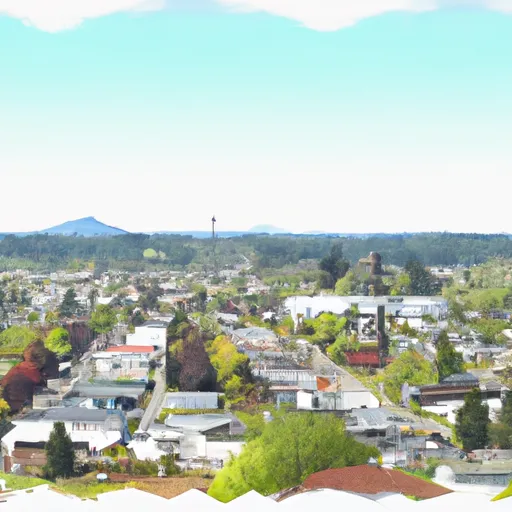-
 Snoflo Premium
Snoflo Premium
Get unlimited access to all our content
With no Ad interruptions! - Start Your Free Trial Login with existing account
Yelm
Eden Index
Climate
8.1
•
Recreation
2.8
•
Community
2.6
•
Safeguard
4.9/10

Yelm, Washington is a small city located in Thurston County, in the western part of the state. It experiences a mild and temperate climate with cool, wet winters and warm, dry summers. The average temperature ranges from the low 30s°F in winter to the high 70s°F in summer.
Hydrologically, Yelm is situated in the Nisqually River watershed, which contributes to the local water supply. The area is known for its abundant rainfall, especially during the winter months, which helps maintain the lush greenery and forests that surround the city.
Yelm offers various outdoor recreational opportunities for nature enthusiasts. The nearby Mount Rainier National Park provides breathtaking views and opportunities for hiking, camping, and wildlife spotting. The Nisqually National Wildlife Refuge is another popular destination, offering wetland trails, birdwatching, and educational programs.
For water enthusiasts, Yelm is located close to numerous lakes and rivers, including Clear Lake and the Deschutes River, providing opportunities for boating, fishing, and swimming. The city also has several parks and trails, such as Yelm City Park and Yelm-Tenino Trail, which are ideal for picnicking, walking, and biking.
In summary, Yelm, Washington, offers a mild climate, abundant rainfall, and various outdoor recreational opportunities, making it an appealing destination for nature lovers and those seeking active pursuits in a picturesque setting.
What is the Eden Index?
The Snoflo Eden Index serves as a comprehensive rating system for regions, evaluating their desirability through a holistic assessment of climate health, outdoor recreation opportunities, and natural disaster risk, acknowledging the profound impact of these factors on livability and well-being.
Climate Health Indicator (CHI): 8.1
Yelm receives approximately
1113mm of rain per year,
with humidity levels near 88%
and air temperatures averaging around
11°C.
Yelm has a plant hardyness factor of
8, meaning
plants and agriculture in this region tend to thrive here all year round.
By considering the ideal temperature range, reliable water supplies, clean air, and stable seasonal rain or snowpacks, the Climate Health Indicator (CHI) underscores the significance of a healthy climate as the foundation for quality living.
A healthy climate is paramount for ensuring a high quality of life and livability in a region, fostering both physical well-being and environmental harmony. This can be characterized by ideal temperatures, reliable access to water supplies, clean air, and consistent seasonal rain or snowpacks.
Weather Forecast
Streamflow Conditions
Puget Sound
Area Rivers
Puget Sound
Snowpack Depths
Puget Sound
Reservoir Storage Capacity
Puget Sound
Groundwater Levels
Recreational Opportunity Index (ROI): 2.8
The Recreational Opportunity Index (ROI) recognizes the value of outdoor recreational options, such as parks, hiking trails, camping sites, and fishing spots, while acknowledging that climate plays a pivotal role in ensuring the comfort and consistency of these experiences.
Access to outdoor recreational opportunities, encompassing activities such as parks, hiking, camping, and fishing, is crucial for overall well-being, and the climate plays a pivotal role in enabling and enhancing these experiences, ensuring that individuals can engage in nature-based activities comfortably and consistently.
Camping Areas
| Campground | Campsites | Reservations | Toilets | Showers | Elevation |
|---|---|---|---|---|---|
| Fort Lewis Military | None | 254 ft | |||
| Mayfield Lake - Tacoma Power | 55 | 444 ft | |||
| Mossyrock Park - Tacoma Power | 152 | 794 ft | |||
| Holiday Park Military - McChord AFB | None | 323 ft | |||
| Camp Murray Beach Military | None | 239 ft | |||
| Penrose Point State Park | 82 | 15 ft | |||
| Ike Kinswa State Park | 103 | 445 ft |
Nearby Ski Areas
Catastrophe Safeguard Index (CSI):
The Catastrophe Safeguard Index (CSI) recognizes that natural disaster risk, encompassing floods, fires, hurricanes, and tornadoes, can drastically affect safety and the overall appeal of an area.
The level of natural disaster risk in a region significantly affects safety and the overall livability, with climate change amplifying these risks by potentially increasing the frequency and intensity of events like floods, fires, hurricanes, and tornadoes, thereby posing substantial challenges to community resilience and well-being.
Community Resilience Indicator (CRI): 2.6
The Community Resilience Indicator (CRI) recognizes that education, healthcare, and socioeconomics are crucial to the well-being of a region. The CRI acknowledges the profound impact of these elements on residents' overall quality of life. By evaluating educational resources, healthcare accessibility, and economic inclusivity, the index captures the essential aspects that contribute to a thriving community, fostering resident satisfaction, equity, and social cohesion.

